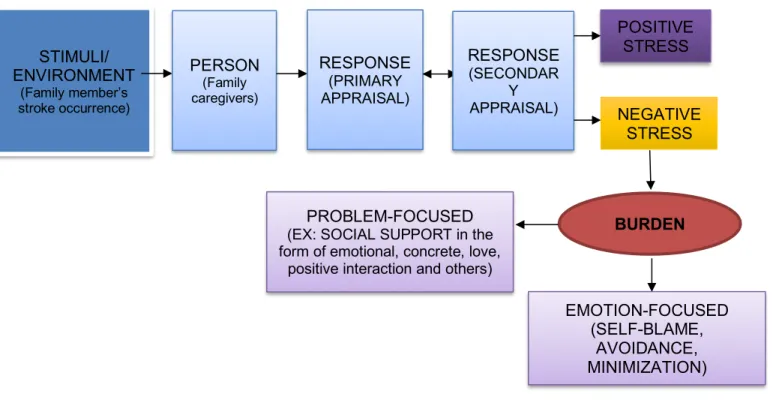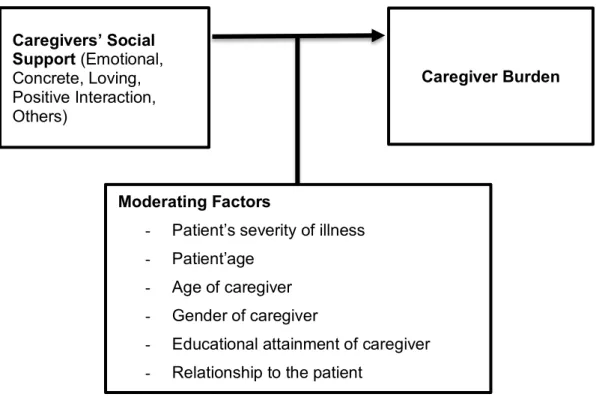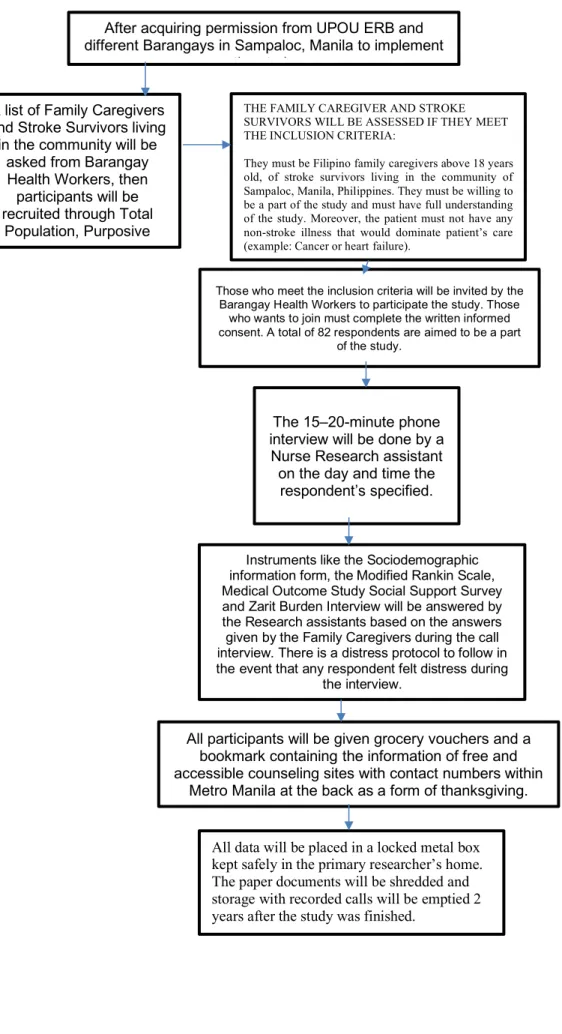Today, approximately 4.8 million stroke survivors with varying degrees of disability require support from family caregivers in the community (Jaracz et al., 2015). In the study, several barangays will be visited to approach family caregivers of stroke survivors living in the community for data collection. Family caregivers of stroke patients living in the community are the target sample population of the study.
Initially, a list of stroke survivors in the community was requested from the Barangay Health Workers of the specified barangays. Next, caregivers of stroke survivors on the list were contacted by the Barangay Health Workers to determine their eligibility to participate. For example, they must be Filipino caregivers over 18 years of age of stroke survivors living in the community of Sampaloc, Manila, Philippines.
They must be Filipino family caregivers over 18 years of age of stroke survivors living in the community of Sampaloc, Manila, Philippines. Sociodemographic data obtained among caregivers of stroke survivors in the selected community in Sampaloc, Manila are as follows: age, gender, educational level, employment status, and relationship with the patient. The common age of onset of Heart Attack in the Philippines is 50 years and older (Mojica & Jerez-Cortez, 2010).
The study result is adapted to the typical age of stroke in the Philippines, which is 50 years and above (Mojica, & Jerez-Cortez, 2010).

Caregiver Burden among Family Caregivers of Stroke Survivors
The noted mean score is 3.4, while the mean score is 3.00, indicating that most of the participating stroke survivors have a moderate degree of disability and would need assistance from a caregiver. For example, caregivers caring for bedridden stroke survivors reported higher levels of burden (Hadi et al., 2016). This may be one of the factors behind the care burden found in almost two-thirds of the relatives who participated in this study.
As a result of stroke, approximately 50% of stroke survivors living in the community require care from a healthcare provider (Denham et al., 2018). Based on the data collected from the 82 respondents, the average Modified Rankin Scale Score of the stroke survivors is 3, which reflects that most of them have moderate disability and may require some assistance; This may influence the caregivers' response to item 1 with a mean score of 1.98, item 8 with a calculated mean of 1.51 and item 14 with a mean of 1.60. Namely, these items relate to their perception of the degree of dependency that stroke survivors have on them due to the functional limitations caused by a stroke.
However, this is not always the case, as identified by caregivers of stroke survivors living in the chosen community. Another consequence of caregiving that can be assessed using the Zarit Burden Interview scale is the distortion of stroke caregivers' personal lives (Lopez-Espuela et al., 2018). One point to consider is that it can be overwhelming for caregivers to perform their usual duties, in addition to the roles previously performed by the stroke survivor (Grant, Hunt, & Steadman, 2014).
Moreover, concern for the stroke survivor's future is also one of the things that relatives have in mind. This concern is really magnified in the Philippines because, in addition to the stroke-related concerns that family caregivers carry, health care is relatively private. As observed, this area (item number 15) has resulted in the highest average of 2.99, which shows that most of the respondents have a greater concern about the financial consequences of stroke, compared to the rest of the categories.
Despite the negative consequences of caregiving, most family members still strive to improve the quality of care provided to stroke survivors. Although respondents answered the last question (item #22) about the overall burden family members experience in caring for stroke survivors, this resulted in one of the lowest averages of 0.9, meaning they are not charge. the answers can be diverse as the standard deviation is 1.48 in a Likert questionnaire with a scale of only 0-5. It can be noted that more than a third of caregivers have no to minimal burden, which amounts to 37.8% of the total number.
Part 3: Perceived Level of Social Support among Stroke Survivor Family Caregivers
One of the factors that can be seen behind the good level of social support perceived by the caregivers who participated in the study could be the propensity of Filipinos on social media. Overall, despite the positive effects that social support has on burden among caregivers (Nayab, & Rukhsana, 2016). The next subscale summarized the concrete form of social support perceived by caregivers and presented summed scores ranging from 7 to 20.
The average score for the concrete support experienced by healthcare providers is at scale level 75, converted to a scale of 0-100. This could possibly explain why the positive interaction subscale has the lowest recorded score among the remaining social support subscales observed for the caregivers participating in the study. Of the remaining social support subscales, this is the second most commonly observed form of support by caregivers of stroke survivors.
His Caregiver Relationship Percei ed Le el of Social S ppor o Caregiver Burden Scale. Pearson correlation through SPSS as prepared to analyze the relationship between the Dice Burden Interview score (reflecting the degree of caregiver burden) and the Medical Outcomes Study Social Support Survey scores (representing the perceived level of caregivers social support). Therefore, the higher the perceived social support of family caregivers, the lower their reported level of caregiver burden and vice versa.
Similarly, the relationship between the Zarit Burden interview and the subscales of the Medical Outcome Social Support Survey scores has been established earlier than the Spearman's correlation. The problem leads to a negative relationship between the level of social support of caregivers and the degree of informal care burden they experience. Several other studies from other countries have shown the positive effect of social support on the level of burden experienced by caregivers.
One of them is the one carried out in some of the Rehabilitation Centers of K Ching Sara ak with 18 participating caregivers, which revealed that the lack of social support is associated with high burden, in addition to other aggravating factors such as Another study with a primary objective assessing the relationship between the presence of social support and coping with the psychological impact of caring for stroke patients among 90 family caregivers of stroke survivors in various hospitals in Pakistan concluded that support social has a vital role in psychological distress. and family caregivers of patients with cerebral infarction. Therefore, it reflects that caregivers' depression is negatively predicted by caregivers' perceived social support from the family (Nayab, & Rukhsana, 2016).
Relationship of the Variables to the Degree of Caregiver Burden
For family members of stroke patients to have knowledge about their susceptibility to experience caregiver burden in order for it to be addressed timely
Outcomes Validity and Reliability of the Modified Rankin Scale: Implications for Stroke Clinical Trials, A Literature Review and Synthesis. Emotional and social consequences of stroke on patient-family-caregiver dyads: analysis ff diverse attitudes and profiles of the different dyads. The impact of stroke on the well-being of the patient's Spo se: An E plorator St d.
Sikosis: Ti sikometriko a panagidilig ti Zarit Burden Interview (ZBI) ken ti Involvement Evaluation Questionnaire (IEQ). Pamilia ken Ayat kas Ontological Foci ti Kalinga (Caring) Ethic iti Panangmatmat iti Lubong dagiti Filipino. Ti panagadalna ket paset ti pannakaileppas ti maysa a proyekto nga indauluan dagiti propesor manipud iti University of the Philippines Open University.
Ang pananaliksik na ito ay bilang tugon sa pagkumpleto ng proyekto sa ilalim ng pangangasiwa ng mga propesor mula sa University of the Philippines Open University. Sa ibaba ay makikita mo ang orihinal na English na bersyon ng Medical Outcomes Study Social Support Survey na ipinadala sa Orange Translation Inc. ay ipinadala. Ang Translate, isang sertipikadong ahensya ng pagsasalin, ay hiniling din na magbigay ng isang propesyonal na pagsusuri ng orihinal na bersyon ng Ingles at ang pabalik na pagsasalin sa Ingles ng Medical Outcomes Study Social Support Survey.
Progress report using the attached form UPOU IREC 3(B): Application form for continuous review every quarter of the year (every 28 June [2022], September [2022], December [2022]) of the start of ethics approval which includes the following: (NOTE: In view of the active ethical review, this report is mandatory even if the study has not started or is still awaiting the release of funds.). University of the Philippines Open University INSTITUTIONAL RESEARCH ETHICS COMMITTEE Los Ba os, Laguna 4031 Tel. Any changes/amendments to the protocol, especially those that may adversely affect the safety of participants during the conduct of the research, including changes in personnel, must be submitted or reported using the attached UPOU IREC form 3 (A: Amendment Submission Form of the Study Protocol.
All the information the UPOU IREC needs to conduct an ongoing evaluation. Notification of the time of completion of the study using UPOU IREC Form 3(C): Final Report Form. UPOU-IREC requires that the final report be submitted no later than 8 weeks after the end of the investigation. Mercy Joy Lubiano, a registered nurse currently pursuing a master's degree mainly focused on adult nursing at the University of the Philippines - Open University.
The aim of this description is to gain a better understanding of the situation of stroke patients and their families. This descriptive study aims to gain a better understanding of the situation of stroke patients and their families.

